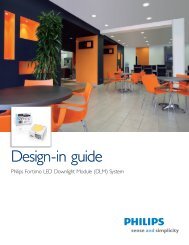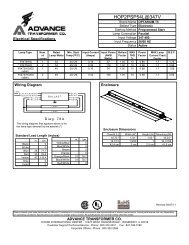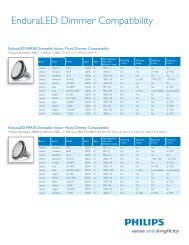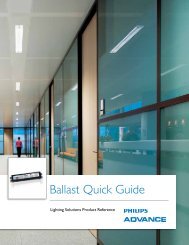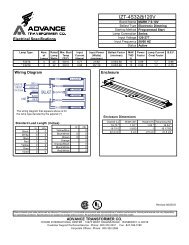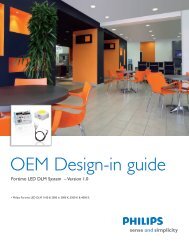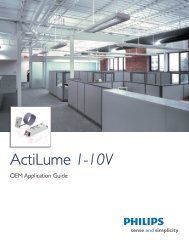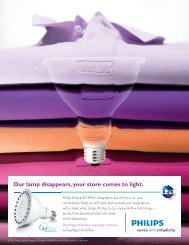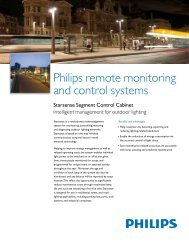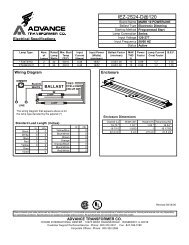Lamp Specification and Application Guide 2008 ... - Philips Lighting
Lamp Specification and Application Guide 2008 ... - Philips Lighting
Lamp Specification and Application Guide 2008 ... - Philips Lighting
Create successful ePaper yourself
Turn your PDF publications into a flip-book with our unique Google optimized e-Paper software.
High Intensity Discharge 121–148 Solid State <strong>Lighting</strong> 149–156 Specialty 157–177 Additional Information 178–189<br />
HIGH INTENSITY DISCHARGE LAMPS<br />
Warnings, Cautions <strong>and</strong> Operating Instructions<br />
WARNINGS, CAUTIONS AND OPERATING INSTRUCTIONS for MasterColor ® CDM Elite Medium Watt Ceramic<br />
Metal Halide Tubular Single-Ended T9 <strong>Lamp</strong>s<br />
Warnings, Cautions <strong>and</strong> Operating Instructions<br />
“WARNING: These lamps can cause serious skin<br />
R burn <strong>and</strong> eye inflammation from short wave ultraviolet<br />
radiation if outer envelope of the lamp is broken or<br />
punctured. Do not use where people will remain for more<br />
than a few minutes unless adequate shielding or other safety<br />
precautions are used. Certain lamps that will automatically<br />
extinguish when the outer envelope is broken or punctured<br />
are commercially available.” This lamp complies with FDA<br />
radiation performance st<strong>and</strong>ard 21 CFR subchapter J. (USA:<br />
21CFR 1040.30 Canada:SOR/DORS/80-381)<br />
If the outer bulb is broken or punctured, turn off at<br />
once <strong>and</strong> replace the lamp to avoid possible injury<br />
from hazardous short wave ultraviolet radiation.<br />
Do not scratch the outer bulb or subject it to<br />
pressure as this could cause the outer bulb to crack<br />
or shatter. A partial vacuum in the outer bulb may<br />
cause glass to fly if the envelope is struck.<br />
WARNING: The arc-tube of metal halide lamps are<br />
designed to operate under high pressure <strong>and</strong> at<br />
temperatures up to 1000°C <strong>and</strong> can unexpectedly rupture<br />
due to internal or external factors such as a ballast failure or<br />
misapplication. If the arc-tube ruptures for any reason, the<br />
outer bulb may break <strong>and</strong> pieces of extremely hot glass<br />
might be discharged into the surrounding environment. If<br />
such a rupture were to happen, THERE IS A RISK OF<br />
PERSONAL INJURY, PROPERTY DAMAGE,<br />
BURNS AND FIRE.<br />
Certain lamps that will retain all the glass particles<br />
should inner arc-tube rupture occur are commercially<br />
available from <strong>Philips</strong> <strong>Lighting</strong> Company.<br />
WARNING: If a lamp is burned in a horizontal position, a<br />
rotation of the lamp over more than 90º around the lamp<br />
axis in the sockets can increase the risk that the arc tube will<br />
rupture. This holds during operation as well as after a cooling<br />
period after switching off the lamp. If one wishes to rotate<br />
the lamp over more than 90º around the lamp axis, one<br />
should do so in steps of less than 90º <strong>and</strong> let the lamp<br />
burn for at least 2 hours between each step.<br />
RELAMP FIXTURES AT OR BEFORE THE END<br />
OF RATED LIFE. Allowing lamps to operate until<br />
they fail is not advised <strong>and</strong> may increase the<br />
possibility of inner arc tube rupture.<br />
This lamp contains an arc tube with a filling gas<br />
containing less than 20 nCi of Kr-85 <strong>and</strong> is<br />
distributed by <strong>Philips</strong> <strong>Lighting</strong> Company, a division of<br />
<strong>Philips</strong> Electronics North American Corporation.<br />
CAUTION: TO REDUCE THE RISK OF PERSONAL<br />
INJURY, PROPERTY DAMAGE, BURNS AND FIRE<br />
RESULTING FROM AN ARC-TUBE RUPTURE THE<br />
FOLLOWING LAMP OPERATING INSTRUCTIONS<br />
MUST BE FOLLOWED:<br />
LAMP OPERATING INSTRUCTIONS:<br />
1. Relamp fixtures at or before the end of rated life.<br />
Allowing lamps to operate until they fail is not advised <strong>and</strong><br />
may increase the possibility of inner arc tube rupture.<br />
2. Use only in an enclosed fixture capable of withst<strong>and</strong>ing<br />
particles of glass having temperatures up to 1000°C.<br />
3. Before lamp installation/replacement, shut power off <strong>and</strong><br />
allow lamp <strong>and</strong> fixture to cool to avoid electrical shock<br />
<strong>and</strong> potential burn hazards.<br />
4. Use only auxiliary equipment meeting <strong>Philips</strong> <strong>and</strong>/or<br />
ANSI st<strong>and</strong>ards. Use within voltage limits recommended<br />
by ballast manufacturer.<br />
A. Operate lamp only within specified limits of operation.<br />
B. For total supply load refer to ballast manufacturers<br />
electrical data.<br />
C. All Pulse Start lamps require a socket rated to<br />
withst<strong>and</strong> a 4,000 volt pulse<br />
5. Periodically inspect the outer envelope. Replace any<br />
lamps that show scratches, cracks or damage.<br />
6. If a lamp bulb support is used, be sure to insulate the<br />
support electrically to avoid possible decomposition of<br />
the bulb glass.<br />
7. Protect lamp base, socket <strong>and</strong> wiring against moisture,<br />
corrosive atmospheres <strong>and</strong> excessive heat.<br />
8. Time should be allowed for lamps to stabilize in color<br />
when turned on for the first time. This may require<br />
several hours of operation, with more than one start.<br />
<strong>Lamp</strong> color is also subject to change under conditions of<br />
excess vibration or shock, <strong>and</strong> color appearance may<br />
vary between individual lamps.<br />
9. <strong>Lamp</strong>s may require 10 minutes to re-light if there is a<br />
power interruption.<br />
10. Take care in h<strong>and</strong>ling <strong>and</strong> disposing of lamps. If an arc<br />
tube is broken, avoid skin contact with any of the<br />
contents or fragments.<br />
11. Use this lamp only in fixtures that contain a Pulse Start<br />
metal halide ballast <strong>and</strong> are specifically designed for use<br />
with Pulse Start metal halide lamps.<br />
WARNINGS, CAUTIONS AND OPERATING INSTRUCTIONS for Protected MasterColor ® Ceramic Metal Halide PAR <strong>and</strong><br />
CDM-R111 <strong>Lamp</strong>s (Open or Enclosed Fixtures)<br />
Warnings, Cautions <strong>and</strong> Operating Instructions<br />
“WARNING: These lamps can cause serious skin<br />
R burn <strong>and</strong> eye inflammation from short wave ultraviolet<br />
radiation if outer envelope of the lamp is broken or<br />
punctured. Do not use where people will remain for<br />
more than a few minutes unless adequate shielding or<br />
other safety precautions are used. Certain lamps that will<br />
automatically extinguish when the outer envelope is<br />
broken or punctured are commercially available.” This<br />
lamp complies with FDA radiation performance st<strong>and</strong>ard<br />
21 CFR subchapter J. (USA:21CFR 1040.30 Canada:<br />
SOR/DORS/80-381)<br />
If the outer bulb is broken or punctured, turn off at<br />
once <strong>and</strong> replace the lamp to avoid possible injury<br />
from hazardous short wave ultraviolet radiation. Do<br />
not scratch the outer bulb or subject it to pressure<br />
as this could cause the outer bulb to crack or<br />
shatter. A partial vacuum in the outer bulb may<br />
cause glass to fly if the envelope is struck.<br />
WARNING: The arc-tube of metal halide lamps are<br />
designed to operate under high pressure <strong>and</strong> at<br />
temperatures up to 1000º C <strong>and</strong> can unexpectedly rupture<br />
due to internal or external factors such as a ballast failure or<br />
misapplication. If the arc-tube ruptures for any reason, the<br />
outer bulb may break <strong>and</strong> pieces of extremely hot glass<br />
might be discharged into the surrounding environment. If<br />
such a rupture were to happen, THERE IS A RISK OF<br />
PERSONAL INJURY, PROPERTY DAMAGE,<br />
BURNS AND FIRE. These lamps are designed to<br />
retain all the glass particles should an arc tube<br />
rupture occur. The following operating instructions<br />
are recommended to minimize these occurrences.<br />
RELAMP FIXTURES AT OR BEFORE THE END<br />
OF RATED LIFE. Allowing lamps to operate until<br />
they fail is not advised <strong>and</strong> may increase the<br />
possibility of inner arc tube rupture.<br />
This lamp contains an arc tube with a filling gas<br />
containing Kr-85 <strong>and</strong> is distributed by <strong>Philips</strong> <strong>Lighting</strong><br />
Company, a division of <strong>Philips</strong> Electronics North<br />
America Corporation, Somerset, New Jersey, 08875.<br />
CAUTION: TO REDUCE THE RISK OF PERSONAL<br />
INJURY, PROPERTY DAMAGE, BURNS AND FIRE<br />
RESULTING FROM AN ARC-TUBE RUPTURE THE<br />
FOLLOWING LAMP OPERATING INSTRUCTIONS<br />
MUST BE FOLLOWED:<br />
LAMP OPERATING INSTRUCTIONS:<br />
1. RELAMP FIXTURES AT OR BEFORE THE END OF RATED<br />
LIFE. Allowing lamps to operate until they fail is not advised<br />
<strong>and</strong> may increase the possibility of inner arc tube rupture.<br />
2. Before lamp installation/replacement, shut power off <strong>and</strong><br />
allow lamp <strong>and</strong> fixture to cool to avoid electrical shock<br />
<strong>and</strong> potential burn hazards.<br />
3. Use only auxiliary equipment meeting <strong>Philips</strong> <strong>and</strong>/or ANSI<br />
st<strong>and</strong>ards. Use within voltage limits recommended by<br />
ballast manufacturer.<br />
A. Operate lamp only within specified limits<br />
of operation.<br />
B. For total supply load refer to ballast manufacturers<br />
electrical data.<br />
C. Operate PAR20 3000K <strong>and</strong> PAR30L 3000K<br />
lamps only on thermally protected ballast.<br />
D. Operate 20W PAR20 3000K <strong>and</strong> 20W<br />
PAR30L 3000K lamps only on thermally<br />
protected electronic ballast.<br />
E. Operate PAR20 4000K <strong>and</strong> PAR30L 4000K<br />
lamps only on thermally protected<br />
electronic ballast.<br />
F. Operate CDM-R111 lamps only on<br />
thermally protected electronic ballast.<br />
4. Periodically inspect the outer envelope. Replace any lamps<br />
that show scratches, cracks or damage.<br />
5. If a lamp bulb support is used, be sure to insulate the<br />
support electrically to avoid possible decomposition<br />
of the bulb glass.<br />
6. Protect lamp base, socket <strong>and</strong> wiring against moisture,<br />
corrosive atmospheres <strong>and</strong> excessive heat.<br />
7. Time should be allowed for lamps to stabilize in color<br />
when turned on for the first time. This may require several<br />
hours of operation, with more than one start. <strong>Lamp</strong> color<br />
is also subject to change under conditions of excess<br />
vibration or shock, <strong>and</strong> color appearance may vary<br />
between individual lamps.<br />
8. <strong>Lamp</strong>s may require up to 10 minutes (4–8 minutes for<br />
CDM-R111) to re-light if there is a power interruption.<br />
9. Take care in h<strong>and</strong>ling <strong>and</strong> disposing of lamps. If an arc tube<br />
is broken, avoid skin contact with any of the contents or<br />
fragments.<br />
10. For proper installation <strong>and</strong> removal, lamp should be<br />
h<strong>and</strong>led by the sides of the reflector <strong>and</strong> not by the<br />
aluminum front anti-glare cap.<br />
<strong>Philips</strong> <strong>Lighting</strong> Company SAG100 <strong>2008</strong>–2009 141



